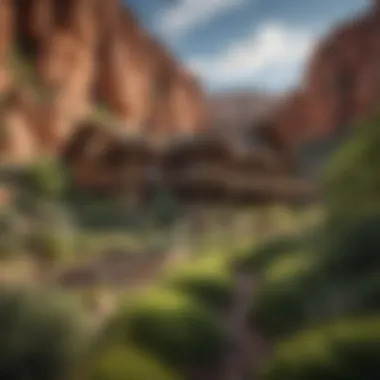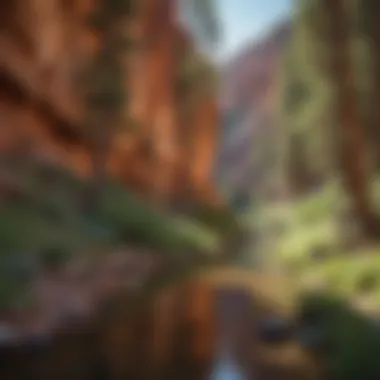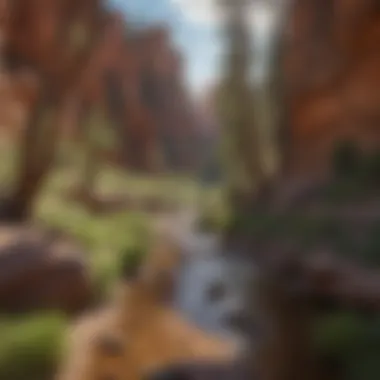Exploring Red Canyon Lodge: A Woodland Gem in Utah


Intro
Nestled in Dutch John, Utah, Red Canyon Lodge stands as a remarkable hub for woodland exploration. This location offers visitors a unique opportunity to engage with the surrounding ecosystem and experience the beauty of the natural world. The lodge not only provides accommodations but also serves as a focal point for sustainable tourism and conservation efforts. This article digs deeper into the features of Red Canyon Lodge, its ecological significance, and how it embodies sustainable tourism.
Throughout the following sections, we will examine woodland ecosystems, discuss sustainable forestry practices, and explore effective woodland stewardship techniques, all of which are essential to maintaining the delicate balance of these environments.
Understanding Woodland Ecosystems
Woodland ecosystems hold tremendous value as they represent a diverse range of species and habitats. These ecosystems contribute immensely to global biodiversity.
Importance of Biodiversity in Forests
Biodiversity refers to the variety of life forms in a given area. In forests, this includes plants, animals, fungi, and microorganisms. High biodiversity is crucial, as it enhances ecosystem resilience against disturbances like climate change or pests. More diverse forests can recover faster from these challenges, ensuring that the ecosystem remains functional and productive.
Role of Forests in Climate Regulation
Forests play a significant role in regulating the climate. Through photosynthesis, trees absorb carbon dioxide and release oxygen, which is vital for all life. Additionally, these woods influence local weather patterns by regulating temperatures and precipitation. When managed correctly, forests can act as carbon sinks, absorbing more carbon than they release.
Sustainable Forestry Practices
Sustainable forestry practices help maintain the health of woodlands while allowing for economic benefits. These practices focus on the long-term health and resilience of the forest ecosystem.
Principles of Sustainable Forestry
Sustainable forestry is grounded in certain key principles:
- Long-lasting ecological health: Ensuring biodiversity and ecosystem functions.
- Economic viability: Providing income and resources without degrading the forest.
- Social responsibility: Involving local communities in decision-making.
Case Studies of Successful Implementations
There are notable examples worldwide where sustainable forestry has succeeded. For instance, the sustainable management practices in the Amazon Rainforest have been effective in balancing the needs of local populations with conservation goals.
Woodland Stewardship Techniques
Effective woodland stewardship requires thoughtful strategies that incorporate both management and conservation practices.
Forest Management Plans
A comprehensive forest management plan serves as a road map for the health of a woodland area. It often includes factors such as:
- Inventory of resources
- Assessment of ecosystem health
- Long-term monitoring strategies
Conservation Strategies
Conservation strategies can significantly affect woodland ecosystems. These strategies might involve:
- Protecting old-growth forests
- Restoring degraded areas
- Engaging in community education
“Sustainable management and stewardship are not just important for preserving our forests; they are crucial for our future.”
Prolusion to Red Canyon Lodge
Red Canyon Lodge stands as a pivotal location in Dutch John, Utah. It serves not only as a gateway to stunning woodland explorations but also integrates sustainable tourism with ecological preservation. This section emphasizes why understanding Red Canyon Lodge is instrumental for visitors seeking an immersive natural experience. The lodge embodies the essence of eco-tourism, prioritizing conservation while offering a comfortable stay. Its diverse offerings cater to outdoor enthusiasts and those interested in environmental stewardship.
Location and Access
Red Canyon Lodge is nestled in the scenic Weber Canyon area of Dutch John. Its proximity to the stunning Flaming Gorge National Recreation Area enhances its appeal. Accessing the lodge is straightforward. Visitors can drive along U.S. Route 191, which is well-connected and easily navigable. The surrounding roads are maintained, ensuring safe travel year-round.
For those opting for public transportation, local shuttle services provide convenient options for reaching the lodge. Being situated close to outdoor recreational areas makes this location particularly advantageous for nature lovers.


Historical Overview
The history of Red Canyon Lodge is steeped in the rich narrative of the region. Established in the late 20th century, it was designed to foster a deep connection between visitors and the natural world. The founders aimed to create a space that would cultivate appreciation for the lush landscape and the unique biodiversity present.
Throughout its history, the lodge has undergone various modifications and improvements while maintaining the original ethos of conservation. The importance of this establishment lies in its role as a base for exploration and engagement with the local ecosystems.
"Red Canyon Lodge is not just a place to stay; it is a sanctuary fostering the discovery of nature's splendor."
This overview sets the stage for understanding its impact on both the local community and visitors alike.
Architectural Design and Facilities
The architectural design and facilities of Red Canyon Lodge play a crucial role in shaping visitor experience and promoting sustainable practices in a woodland setting. These design elements not only cater to the comfort and needs of guests but also reflect a profound respect for the surrounding environment. The Lodge achieves a balance between aesthetic appeal and functional necessity, making it a favorite among ecologically-minded travelers.
Construction Materials
The choice of construction materials at Red Canyon Lodge is indicative of its dedication to environmental harmony. Local materials are prioritized to minimize transportation impacts and promote regional craftsmanship. Log cabins, made primarily of pine, are a prominent feature of the architecture, which provides authenticity and a sense of place. The natural wood finishes blend seamlessly into the forest surroundings, fostering a connection with nature.
The use of sustainable building techniques is evident. Energy-efficient windows and insulation materials help reduce heating and cooling needs, significantly lowering the overall carbon footprint. Moreover, the structure exhibits durability, ensuring a long lifecycle. These choices are not merely aesthetic; they resonate with the principles required for sustainable tourism and land stewardship.
Accommodations Offered
Red Canyon Lodge offers various accommodations, catering to a range of preferences and needs. Visitors can choose from cozy cabins designed for couples or families, to larger lodges suitable for group gatherings. Each option is thoughtfully designed, providing modern conveniences while maintaining a rustic charm.
The interiors are well-furnished with natural light flowing through large windows that spotlight the wood craftsmanship. Many cabins feature kitchens, which allow guests to prepare their own meals, supporting local food practices and reducing waste from dining facilities. Outdoor spaces, such as porches and fire pits, encourage connection with nature. These accommodations promote a sense of tranquility that complement the stunning natural landscape of Dutch John, Utah.
Sustainability Features
Sustainable features at Red Canyon Lodge extend beyond construction materials and include various operational practices. The Lodge employs water conservation techniques such as low-flow faucets and greywater recycling systems, helping to preserve local water resources.
Additionally, the Lodge invites guests to engage in environmentally friendly practices. Recycling bins are readily available, and educational materials promote awareness about the local ecology and conservation efforts.
These initiatives are integral to the mission of the Lodge, which aims to be a model for sustainable tourism. By aligning their facilities with ecological principles, Red Canyon Lodge not only provides a memorable experience but also encourages visitors to become stewards of the environment.
"Sustainable tourism is not just a trend; it is a necessity in preserving our planet for future generations."
Such alignment of architectural design, accommodations, and sustainability practices speaks volumes about Red Canyon Lodge’s commitment to eco-tourism and serves as a benchmark for similar establishments.
Ecological Significance of the Surrounding Area
Understanding the ecological significance of the area surrounding Red Canyon Lodge is vital for both conservation efforts and visitor appreciation. The region is not only a beautiful backdrop for outdoor activities, but it also plays a critical role in the local ecosystem. Many interconnected factors contribute to the ecological health of Dutch John, Utah, and its forests.
A primary element is biodiversity, which refers to the variety of life found in this region. Biodiversity enhances ecosystem resilience, making it capable of withstanding environmental changes. The numerous species of plants, animals, and microorganisms each fill specific niches within the ecosystem. This complex web of life offers numerous benefits, including air and water purification, pollination of plants, and sustenance for wildlife. The protection of this diversity is essential for maintaining the ecological balance.
Moreover, the local ecosystems and habitats within the surrounding area are crucial for understanding the overall health of the environment. Each habitat type, whether it be forest, wetland, or grassland, supports distinct communities of organisms. Preserving these habitats ensures the survival of various species. Changes to these systems can lead to loss of biodiversity, which can have ripple effects throughout the entire ecosystem.
"Healthy ecosystems provide essential services that benefit humans and wildlife alike."
Biodiversity in the Region
Biodiversity within the area around Red Canyon Lodge is characterized by a rich variety of flora and fauna. The forests are home to trees such as Ponderosa Pine, Aspen, and Engelmann Spruce. Each of these species contributes to the overall structure and function of the forest ecosystem.
Animal life is equally diverse. Species such as deer, elk, and various birds thrive in the habitats provided by the dense forest and clear waters. This variety creates a dynamic food web. Furthermore, the presence of certain species can indicate the overall health of the ecosystem. For instance, amphibians are often used as bioindicators due to their sensitivity to environmental changes.
Local Ecosystems and Habitats
The local ecosystems around Red Canyon Lodge are defined by several specific habitats. Each offers unique conditions that support different communities of plants and animals.
- Forests: The coniferous forests provide critical shelter and food for many species. These trees also play a role in carbon sequestration, contributing to climate regulation.
- Wetlands: Wetland areas are vital for water filtration and flood protection. They also support unique species that depend on such habitats.
- Streams and Rivers: The waterways in the area are crucial for various life forms. They provide necessary hydration for wildlife and support aquatic species that are integral to the ecosystem.


Activities and Experiences at the Lodge
Activities at Red Canyon Lodge play a pivotal role in enhancing visitor engagement while simultaneously promoting appreciation for the natural environment. Engaging in these activities contributes to a deeper understanding of the local ecosystems and the overall mission of sustainable tourism in the region. Visitors can immerse themselves in a variety of experiences, from outdoor adventures to wildlife observation and educational programs. Each facet not only enriches the visitor experience but also fosters a sense of connection to the landscape and its stewardship.
Outdoor Adventures
Red Canyon Lodge offers a plethora of outdoor adventures tailored to all levels of experience. Guests can participate in hiking, fishing, and boating — all essential to explore the stunning wilderness surrounding the lodge. For hiking enthusiasts, well-marked trails lead to breathtaking vistas and unique geological features. These paths are designed for both novice and seasoned hikers alike, providing a safe environment to connect with both nature and fellow adventurers.
Fishing in the region is noted for its abundance, with local lakes and streams stocked with various fish species like trout. This activity not only provides recreational enjoyment but can also educate participants about local aquatic ecosystems and conservation efforts. Boating opportunities allow guests to navigate the waters, offering a unique perspective on the landscape while observing the diverse wildlife often seen along the shores.
Wildlife Observation Opportunities
Wildlife observation is another critical activity offered at Red Canyon Lodge. Visitors can expect to encounter a wide range of animals, including deer, elk, and various bird species, which enrich the ecological tapestry of the area. Observing these creatures in their natural habitat allows guests to gain insights into their behaviors and interactions with the environment.
Scheduled tours and guided observation sessions help maximize wildlife spotting opportunities. Knowledgeable guides share valuable information regarding the importance of various species, their habitats, and conservation practices. This effort promotes a culture of respect and understanding towards wildlife and enhances visitors’ appreciation for biodiversity.
"Experiencing wildlife in its natural habitat inspires not only awe but a responsibility for conservation."
Educational Programs Offered
Educational programs at Red Canyon Lodge serve as an integral component of the visitor experience. These programs cover various topics such as conservation strategies, local flora and fauna, and ecological practices. Programs are designed to engage participants through interactive learning, often including hands-on activities and expert-led discussions.
Participants in these programs gain a comprehensive understanding of the delicate balance within woodland ecosystems. They learn how their actions, whether through recreation or daily living, impact the environment. This knowledge creates advocates for sustainability, encouraging individuals to take what they learn back into their communities.
Overall, the activities and experiences at Red Canyon Lodge are not just recreational but also educational. They forge connections between visitors and the land, elevating personal investment in environmental stewardship. Such involvement is crucial, as it cultivates a community of informed individuals who appreciate and protect natural resources.
Cultural and Community Engagement
Cultural and community engagement at Red Canyon Lodge serves as a pivotal component in enhancing the visitor experience while promoting sustainable practices. This engagement allows visitors to connect with the heritage of the local area and the natural environment. It also fosters a sense of responsibility among visitors, encouraging stewardship and support for conservation initiatives. Key elements include partnerships with local communities, educational programs, and active participation in preserving the surrounding ecosystems.
Connection with Local Communities
The relationship between Red Canyon Lodge and local communities is multifaceted, enhancing both tourism and local livelihoods. This connection encourages a deeper understanding of the region’s cultural history and ecological significance.
Local residents often share their traditional practices and knowledge with visitors, providing insight into sustainable living and environmental stewardship. This leads not only to a richer experience for tourists but also helps promote local arts, crafts, and culinary traditions.
Involving community members in the management and operation of the lodge can bring several benefits, including:
- Economic Growth: Increased tourism stimulates local businesses and creates job opportunities.
- Cultural Preservation: Local traditions and stories can be preserved through engagement initiatives.
- Ecological Awareness: Community involvement helps enhance local ecological awareness, contributing to better conservation practices.
Those visiting Red Canyon Lodge will find opportunities to engage with local communities through workshops, guided tours, and cultural events, all designed to bridge the gap between nature and culture.
Volunteering and Stewardship Programs
Volunteering and stewardship programs at Red Canyon Lodge offer structured avenues for visitors to contribute positively to the local environment and communities. These initiatives often focus on practical conservation tasks, such as habitat restoration or trail maintenance, reinforcing the value of hands-on participation.
Participants in these programs gain first-hand experience in ecology and conservation, which can cultivate a lasting respect for natural environments. Some significant aspects of these programs include:
- Practical Experience: Volunteers can learn about local flora and fauna while participating in essential conservation work.
- Community Building: Engaging in stewardship fosters a sense of community among volunteers from diverse backgrounds.
- Impactful Contributions: Vegetation planting and clean-ups can result in meaningful improvements to local ecosystems.
- Educational Opportunities: These programs can include workshops, lectures, and guided discussions about environmental issues, which can deepen understanding and inspire advocates for conservation.
In summary, cultural and community engagement is more than just an aspect of visiting Red Canyon Lodge; it serves as a cornerstone for holistic and enriching experiences. From forming meaningful connections with local communities to actively participating in stewardship programs, these elements ensure that visitors leave with a greater appreciation for the woodland ecosystems and the people who inhabit them.
Visitor Information and Guidelines
Understanding the importance of visitor information and guidelines is crucial for those planning a trip to Red Canyon Lodge. These guidelines help ensure a safe and enjoyable experience. They also reflect the lodge's commitment to sustainable practices and preservation of the surrounding environment. By being informed, visitors can enhance their understanding of the local ecosystem and engage in responsible tourism.
Best Times to Visit
The timing of your visit can greatly affect what you will experience. The ideal time to visit Red Canyon Lodge is during the spring and fall. During spring, wildlife is more active, and the flora begins to bloom. In fall, the changing foliage provides a stunning backdrop for hiking and photography. Summer can be hot, but it is also peak tourist season, offering a variety of activities. Winter, while cold, creates an opportunity for snow sports, but visitors should pack accordingly for frigid temperatures.
Reservation Procedures
Making reservations at Red Canyon Lodge is recommended for a smooth experience. The process can typically be completed online through the lodge's website. Visitors may also call directly to inquire about availability, discuss accommodations, and clarify any specific requirements. Early booking is advisable, especially during peak seasons when demand is high.
"Being proactive about your reservation ensures a spot at this unique lodge and helps you plan your itinerary effectively."


What to Expect on Arrival
Upon arrival, guests will find a warm and welcoming atmosphere at Red Canyon Lodge. Check-in procedures are straightforward, intended to make the transition seamless. Visitors can expect an introduction to the lodge's facilities, including dining options and access to local trails. The staff is knowledgeable about the area and can provide valuable insights regarding nearby attractions and activities. Before exploring, it is wise for guests to familiarize themselves with the lodge's rules and regulations to foster a respectful relationship with nature.
Challenges Facing Red Canyon Lodge
The ability of Red Canyon Lodge to serve as a cornerstone for woodland exploration is not without its challenges. Understanding these challenges is crucial for both the management of the lodge and visitors. They encompass environmental threats and regulatory issues that can impact ecological integrity and visitor experiences. Addressing these factors is key to sustaining the lodge's operation in a way that aligns with its commitment to conservation and visitor engagement.
Environmental Threats
Red Canyon Lodge is surrounded by diverse ecosystems that are sensitive to various environmental threats. Climate change poses significant risks, as rising temperatures and changing precipitation patterns can affect local flora and fauna. Drought conditions may lead to reduced water levels in nearby rivers and lakes, impacting wildlife and visitor activities like boating and fishing.
Additionally, invasive species threaten the native biodiversity of the area. Species such as cheatgrass can outcompete native plants for resources, altering habitat structures and diminishing the ecological balance. It's essential for lodge management to monitor these threats closely and implement strategies to control invasive species, ensuring the preservation of natural habitats.
Key environmental threats include:
- Climate Change: Affecting weather patterns and resource availability.
- Invasive Species: Competing with native flora for nutrients and space.
- Pollution: Runoff from nearby developments can harm aquatic ecosystems.
Regulatory and Management Issues
Addressing regulatory and management issues is vital for the long-term success of Red Canyon Lodge. Bureaucratic red tape can complicate conservation efforts and limit the lodge's ability to respond to environmental challenges effectively. Regulations concerning land use and wildlife protection may require careful navigation. Coordination with local government bodies and environmental organizations is essential.
In addition, there is a need for effective management practices that align with sustainable tourism. Balancing visitor demand with conservation priorities can be challenging. Implementing visitor education programs is critical to raise awareness about responsible recreation and the importance of protecting local ecosystems.
Essential issues include:
- Coordination with Regulatory Bodies: Ensuring compliance with conservation laws.
- Sustainable Management Practices: Balancing tourism with ecosystem preservation.
- Visitor Education: Promoting responsible behaviors among guests.
"Sustainability within the tourism industry requires a profound commitment to both environmental stewardship and community engagement."
By recognizing and addressing these challenges, Red Canyon Lodge can better position itself as a leader in sustainable tourism, ensuring that both the lodge and its surrounding environment can thrive for years to come.
The Future of Red Canyon Lodge
The future of Red Canyon Lodge is pivotal, not only for its ongoing operations but also for the surrounding ecological systems and local communities. Emphasizing sustainable development principles, the lodge can serve as a model within the tourism sector. This not only ensures that the natural resources are managed responsibly but also enhances visitor experiences while preserving the region's biodiversity. The significance of what lies ahead for the lodge is multi-faceted; from fostering community engagement to ensuring the longevity of the natural ecosystems supporting its existence, the lodge's trajectory holds great promise.
Sustainable Development Goals
Sustainable development goals play a crucial role in shaping the future of Red Canyon Lodge. These goals encompass various aspects such as environmental integrity, economic viability, and social equity. By aligning their operations with the United Nations Sustainable Development Goals, Red Canyon Lodge can prioritize actions that foster sustainability. This can include initiatives such as:
- Reducing waste: Implementing recycling programs to minimize landfill contributions.
- Conserving energy: Utilizing renewable energy sources, such as solar panels, to reduce carbon footprints.
- Supporting local economies: Engaging with local artisans and suppliers to promote regional products.
- Enhancing visitor education: Conducting workshops on environmental conservation and the importance of local ecosystems.
By focusing on these goals, the lodge can remain a significant contributor to sustainable tourism practices while drawing eco-conscious travelers who appreciate these values.
Long-Term Conservation Strategies
Long-term conservation strategies are essential in safeguarding the ecological integrity of the area surrounding Red Canyon Lodge. These strategies should be comprehensive and involve various stakeholders, including local governments, conservation organizations, and the community itself. Some of these strategies might include:
- Habitat restoration: Undertaking projects that restore degraded areas to their original biological health, promoting biodiversity.
- Research collaboration: Partnering with academic institutions for biodiversity research, which provides valuable data for informed conservation efforts.
- Wildlife protection initiatives: Collaborating with wildlife organizations to protect endangered species and their habitats, ensuring healthy wildlife populations.
- Monitoring programs: Establishing monitoring initiatives to assess the health of ecosystems regularly and adjust conservation practices accordingly.
Engaging in long-term conservation not only assures the lodge's environmental impact is mitigated but also fortifies its reputation as a responsible tourism destination. The lodge's commitment to these strategies can inspire other entities within the industry to follow suit, creating a ripple effect for sustainability in tourism.
End
Summary of Key Points
- Ecological Significance: The lodge's location is integral for understanding local biodiversity and ecosystems. It serves as a base for observing the complex relationships among flora and fauna.
- Community Involvement: Engagement with local communities enhances the visitor experience while supporting economic sustainability in the region.
- Challenges and Future Directions: Acknowledging environmental threats and management issues is crucial for the lodge to thrive. Future strategies will focus on promoting sustainable development and conservation efforts effectively.
Call to Action for Nature Enthusiasts
For those passionate about nature and sustainability, Red Canyon Lodge presents an excellent opportunity to engage with the environment in meaningful ways. Whether through wildlife observation, participating in conservation initiatives, or simply enjoying the natural beauty, your involvement matters.
Consider visiting or supporting local programs that aim to protect and preserve the unique habitats of this region. By investing time and effort in eco-tourism, we contribute to the stewardship of our natural world, ensuring that future generations can also experience the wonders of places like Red Canyon Lodge.
"Every small action can lead to significant change. Embrace the outdoors and advocate for preservation."
By fostering a collective sense of responsibility, we can uphold the values that make destinations like Red Canyon Lodge vital not only for recreation but for the integrity of woodland ecosystems.







